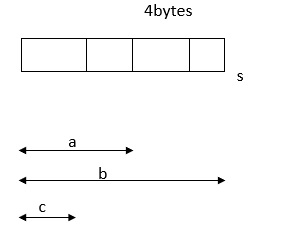
 Data Structure
Data Structure Networking
Networking RDBMS
RDBMS Operating System
Operating System Java
Java MS Excel
MS Excel iOS
iOS HTML
HTML CSS
CSS Android
Android Python
Python C Programming
C Programming C++
C++ C#
C# MongoDB
MongoDB MySQL
MySQL Javascript
Javascript PHP
PHP
- Selected Reading
- UPSC IAS Exams Notes
- Developer's Best Practices
- Questions and Answers
- Effective Resume Writing
- HR Interview Questions
- Computer Glossary
- Who is Who
Explain the Union to pointer in C language
A union is called as a memory location, which is shared by several variables of different data types.
Syntax
The syntax is as follows −
union uniontag{
datatype member 1;
datatype member 2;
----
----
datatype member n;
};
For example,
union sample{
int a;
float b;
char c;
};
Declaration of union variable
Given below are the respective declarations of union variable −
Union sample
{
int a;
float b;
char c;
}s;

Union
{
int a;
float b;
char c;
}s;
Union sample
{
int a;
float b;
char c;
};
union sample s;
When union is declared, the compiler automatically creates a variable which hold the largest variable type in the union.
At any time, only one variable can be referred.
Initialization and accessing
- Accessing union member is same as the structure.
- Generally, the dot operator is used for accessing members.
- The arrow operator ( ->) is used for accessing the members
- There is no restriction while using data type in a union.
Example
Following is the C program for union to pointer −
#include<stdio.h>
union abc{
int a;
char b;
};
int main(){
union abc var;
var.a=90;
union abc *p=&var;
printf("%d%c",p->a,p->b);
}
Output
When the above program is executed, it produces the following result −
90Z

Advertisements
